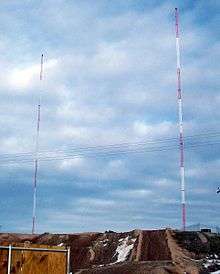KIHU
KIHU (1010 AM) is a Catholic radio formatted radio station licensed to Tooele, Utah, United States. The station is owned by Immaculate Heart Media, Inc.. The station has a construction permit from the FCC for a power increase to 50,000 watts Daytime, 42,000 watts Critical Hours (within two hours after sunrise or before sunset) and 194 watts night. The facilities authorized by the Construction Permit were built in 2004 and the station is operating under "Program Test Authority" with those facilities. Not only does the station have a construction permit to change its power, it also has an application to move its city of license to Magna, near where its current transmitter lies.[2][3][4] The change in city of license will make possible the upgrading of the station from Class "D" to Class "B."[5]
| City | Tooele, Utah |
|---|---|
| Branding | Relevant Radio |
| Frequency | 1010 kHz |
| First air date | July 3, 1956[1] |
| Format | Catholic radio |
| Power | 50,000 watts day 42,000 watts critical hours 194 watts night |
| Class | D |
| Facility ID | 35687 |
| Transmitter coordinates | 40°45′50″N 112°0′50″W |
| Call sign meaning | K Immaculate Heart Utah |
| Former call signs | KTUT (late 1950s) KDYL (1960s to 1982) KTLE (1982-1992) KTUR (1992-1998) KIQN (1998-2004) KCPW (2004-2009) KPCW (2009-2009) |
| Owner | Immaculate Heart Media, Inc. |
| Webcast | Listen Live |
| Website | KIHU website |

1010 AM is a Canadian clear-channel frequency.
History
The station was built to operate on 990 kHz with a 1000 watt transmitter in the town of Tooele. It was officially launched on July 3, 1956. The original call letters were KTUT, and were changed to KDYL in the early 1960s when that call was released from the 1320 station in Salt Lake City when that station was renamed "KCPX." Simmons paid the then owner, Thomas W. Mathis, to release the "KDYL" call so that they could use those call letters on the 1280 Salt Lake City Station, whereupon the station was assigned the call letters KTLE, beginning on 1982-05-19. KTLE stood for Tooele, the station's city of license and former location of its transmitter. In 1982, Mr. Mathis applied to change the frequency to 1010 from 990 kHz and increase the power to 50,000 watts Daytime and 2500 watts Critical Hours at the original transmitter site in Tooele. The change in frequency and power increase was finally built by the subsequent owner in 1992. In 1994, the station applied to move the transmitter to the Salt Lake Valley, at a site that was too close to the Salt Lake International Airport to allow a reasonable tower height (tower was only 142 feet).
On October 30, 1992, the station changed its call sign to KTUR by the then owner, Robert Turley, and on September 18, 1998 to KIQN by the subsequent owner, Intelliquest Media. Intelliquest went bankrupt in 2003, and Community Wireless purchased the License from the Bankruptcy Trustee. Community Wireless then rebuilt the station at its current transmitter site. In January 2004, the station applied to change its city of license to Magna, of which the application is still pending before the FCC. On August 1, 2004, the station became KCPW, and on March 20, 2009, the station became KPCW.[6][7]
In August 2009, the station was assigned the call KIHU, reflecting an ownership change, as it had been sold to IHR Educational Broadcasting. The station now broadcasts Catholic religious programming, which began August 22, 2009.[8] The station flipped to the Relevant Radio branding when IHR Education Broadcasting and Starboard Media Foundation consummated their merger on June 30, 2017.
Tower collapse
On March 18, 2020, a 5.7 magnitude earthquake happened near Magna, Utah, southwest of the station's tower. The earthquake knocked KMRI off the air, after its tower collapsed. Because KIHU used both towers at night to operate directionally, the station will have to file a special temporary authority and likely operate at reduced power until the tower can be rebuilt. KIHU was running on a generator and operating at reduced power following the earthquake.[9]
References
- http://www.americanradiohistory.com/Archive-BC-YB/2010/D4-2010-BC-YB-7.pdf
- "KIHU Application Search Details". United States Federal Communications Commission, audio division.
- "KIHU Facility Record". United States Federal Communications Commission, audio division.
- "KIHU Station Information Profile". Arbitron.
- http://transition.fcc.gov/fcc-bin/amq?list=0&facid=35687
- "Broadcast History - Salt Lake City Radio". Paul Wilson.
- "Call Sign History". FCC.
- KIHU 1010
- "Salt Lake earthquake". Talking Utah Radio. March 18, 2020.
External links
- Query the FCC's AM station database for KIHU
- Radio-Locator Information on KIHU
- Query Nielsen Audio's AM station database for KIHU